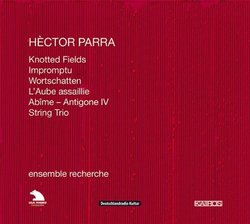Transformative energies of timbre
scarecrow | Chicago, Illinois United States | 02/28/2010
(5 out of 5 stars)
"difficult to write on a timbral creator in mid-stream;
Parra's compositional voice is simply emerging as we speak;although today modernity still finds a cross-border paradigm; it would be odious to formulate theories along "national" after-modernity era;yet capital does control the "centers" of where funds animate and instigate creativity as always;
Latin composers have had to emigrate to study composition in Europa capitals, as Paris and Berlin;
Parra's voice holds fascination for chamber gestures as herein represents to date;
There is an lifeworld(lebenswelt) affinity for discovering if modernity still has an existence without doning it with after programmatic elements as you find in composers who mount a deeply spiritual place to animate what they do and how they think about what they do;The "Spirit" is also easily exploitable by "forcefields" of the market;
Parra's music is exquistely written; you can see thru the compact classic forms he distributes; as the two Trios here with piano;# 2 (2007)engages one with the wonderful extended string timbres,punctuated by the muted striking of a single piano basso tone;He loves that percussive dryness, brings a "force" the the string cadres herein;
Ample sforzato sul ponticello; gliss, tremoli fast and furioso,pizz with arco, machine like rapidity;a touchstone for modernity scorrevole; with violent scraps, like a parrot is being choked,or metal against concrete at 70 miles an hour; the more gong-like piano chords are welcome relief in this context;
likewise the "string trio" (2006) without piano this time, this is a genre that has well-been defined within the dodecaphonic forcefields; gestures here are quite different, Parra understands where problems have existed in the literature; even Parra's teacher Ferneyhough has resolves these "trio problematics" of similar dimensions;
the electronics Parra decides to em-deploy makes the frequent fragemnted gestures much larger more expansive, extensive.
Utilizing the string timbres themselves to generate developed "regions" fragments was a touch of genius; something he must have learned while working at IRCAM and his other mentor Jonathan Harvey;
the short piano solo "impromptu"(2005) again is a condensed,impacted work, Parra understands the piano, an instrument he devoted years of contemplation while in Barcelona. Here the durational frame of 3:26 is misleading; the work renders an imaginative realm far longer indelible;
Parra's music needs much listening experience, one hearing is simply nothing; there are countless variegated internal relationships within the music,energy fields in fragments although he loves the surface 'tutti' of summoning all the forces for declamations;
"L'Aube assaillie" (2005) utilizes again the paradigm of electronics with a solo violoncello, and the soloist narrative is not sacrificed as we many times find; It is still an uncomfortable un-natural marriage of the two; great minds have yet to devise convincing creative solutions to this acoustic-electronics probelmatics;AMM,or Nono and Stockhausen went to LIVE electronics as a satiisfying solutions, and or improvisation;
Here Parra's dense yet threadbare cello lines are captivating;and the electronics can come to be derivative,clee-shay-ist;So the work fails at that level, there should always be a natural force at work, where the two are never compromised by their own histories;
But fragments thrown together,shaped, and filtered,giving architecture always work in modernity,
Yes he is still trying to discover his voice, and he does with an 'Antigone' reading in "Abime" the eariliest work herein a collborative work with physicist Lisa Randall, particle physics, cosmology, string theory, are eminent domians for modernity, the"science" of composition is what Parra prefers, yet the "stream of consciousness" is here explored as well;
All his music is highly controlled,and well played by incredible musicians."


 Track Listings (9) - Disc #1
Track Listings (9) - Disc #1